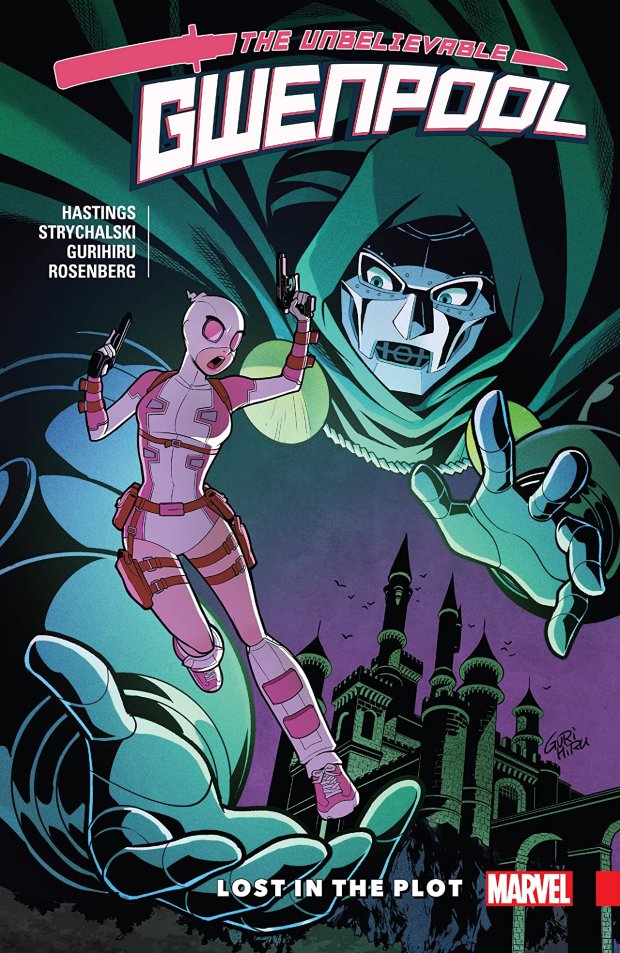by Christopher Hastings, Irene Strychalski, Gurihiru, Rachelle Rosenberg
collects The Unbelievable Gwenpool #21-25
debut series: volumes one | two | three | four | five [complete]
miniseries: Gwenpool Strikes Back
Gwenpool’s first series comes to a close with issue 25, and this final volume was a mixed bag. It’s worth the read for any Gwenpool fan – or, frankly, anyone who’s made it through all four volumes – and to me, the good elements outshine the drawbacks. Overall, one’s opinion of this closing volume will likely depend on your investment in Gwen, and how much you like reflective meta in your comics.
The first two issues of Gwenpool fall flat – Gwen tries to hunt down Doctor Doom because if she defeats him, for some reason, she’ll be able to join the Avengers – for some reason! Her panel-jumping powers develop a bit too, and it’s fun to see Strychalski and later Gurihiru play with form and perspective. But it’s largely aimless with little payoff until the third issue, more than halfway through, when Gwen reveals it’s about mortality – in a sense. Gwen sees her pages running out, knowing she’s about to be cancelled, and neither an Avengers membership nor compliance with being a supervillain can change it. Gwen (and unsurprisingly, Hastings) chose the right villain to hear Gwen out: a newly reformed Doctor Doom with an understanding of multiple dimensions – and rebooting your own story. Finally, the book shifts into a more meaningful and reflective closing chapter.
Is it possible readers in 2018 were kept in the dark about Gwen’s cancellation until this issue? Perhaps, and that surprise might have had a huge payoff. But more often, readers learn months in advance between solicits, publisher announcements, and creative teams working on new titles. Instead, the midway “surprise” feels like a lot of time was lost in getting there. As Gwen starts to see her final pages count down, I couldn’t help but think of the forty or so spent in the first couple issues.
The rest of the book has a gentle pace as we see multiple guest stars – including Hastings’ sweet, silly Baltroc – return, as Gwen, breaking the fourth wall and beyond, meditates on her cancellation and what that means for her tiny pocket of the Marvel universe. What about characters invented for her title? How will future writers change Baltroc? As another character mentions, this is a far cry from trigger happy Gwen in the first volume, who was happy to murder anything that moved, because in her mind, none of it was real. There are some very sweet moments, particularly the very last issue, and I appreciate that Hastings pushes the envelope on the particular Gwenpool style of meta that can only be achieved in her book.
Unfortunately, the ending is also a mixed bag. There’s a predictable time-travel twist, because something very similar was used in the opening issues – it probably had more of a punch in the individual issues with months in between. There are some happy endings and cameos, which is nice to tie up loose ends, but some characters like Cecil weren’t given enough time for much payoff. Also, odd to not see an Easter egg for Gwen’s participation in the West Coast Avengers team book, whose premiere issue premiered six months after Gwen’s closing issue. (Perhaps it was also a reveal at the time.) And while WCA’s writer Kelly Thompson might not have known how this series would end, an opening line from Gwen connecting the two books would have been very sweet.
The art for Gwen’s final chapter is appropriately divided between her two central artist teams. First was Irene Strychalski and Rachelle Rosenberg, who take the lead for the first three issues, and the final two were wrapped up by Gurihiru (aka Sasaki and Kawano), who probably worked on Gwen’s title the most. Personally, I’m not a fan of Strychalski’s style – especially panels with maskless Gwen, whose eyes always looked off. I resonate much more with Gurihiru, but that could be because my first Gurihiru book (of many) was volume one of Gwenpool.
Even though this wasn’t the strongest conclusion to Gwenpool’s first solo series, it’s still a strong celebration of her character, growing far beyond the joke variant cover that launched her as a lovable, witty antihero. It’s wonderful to see that her character has continued to live on, both in and outside comic book pages; and I’m looking forward to reading her latest solo series, Gwenpool Strikes Back, very soon.

5 comments